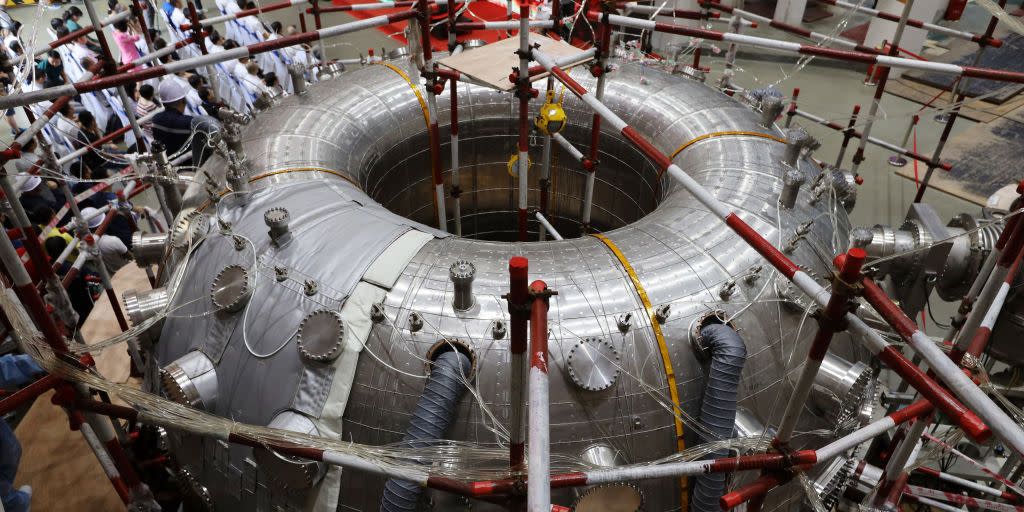To Usher in the ‘Fusion Age,’ Scientists Must Reckon With Unruly Plasma Spurts

Fusion researchers are raising the energy of the plasmas in their reactors so they can generate more power using smaller tokamak equipment.
When plasmas circulate in this highly energized state, they can spurt against the walls of the tokamaks, damaging their interior components.
A new study performed in Korea shows that magnetic controls can successfully manage these eruptions, resulting in smoother flow and reduced maintenance.
Plasmas inside tokamaks—the doughnut-shaped devices that can contain nuclear fusion reactions—can be unruly to manage.
Spurts of very hot plasma, similar to the solar flares that erupt from the surface of the sun, come from the system operating at a high energy level, and can overheat the tokamak’s interior components. (A plasma is formed by heating gas until it is ionized. Nebulas, auroras, and lightning all contain glowing plasmas.)
⚡️ Science explains the world around us. We’ll help you make sense of it all—join Pop Mech Pro.
Seeking stability for fusion reactions, an international team of physics researchers has developed a sophisticated combination of magnetic controls to reduce these plasma spurts that can damage tokamaks. They published their work earlier this year in the journal Physics of Plasmas.
Plasma Instabilities
Inside a tokamak, deuterium, an isotope of hydrogen, circulates at a very high temperature and a low density. Tritium, a second isotope of the same material, may be there as well. Isotopes of an element have different numbers of neutrons in their nuclei from each other, but the same number of protons.
The core of a plasma in a tokamak can be 100 million degrees Celsius, Egemen Kolemen, an associate professor at Princeton University’s Department of Mechanical and Aerospace Engineering and a coauthor of the paper, tells Popular Mechanics. The wall temperature is between 400 and 1,260 degrees Celsius.
Deuterium travels around the doughnut-shaped torus. The torus is inside a strongly constructed outer container. Electromagnetic forces direct the deuterium along its path. If instabilities occur in the plasma, such as edge-localized modes, the ions can damage the inside of the torus.
Edge-localized modes “are bursts of energy” that emerge at the end of the plasma and hit the wall, Kolemen explains. “These bursts lead to huge increases of heat load on the machine wall.”
In early fusion research, edge-localized modes did not occur because the plasma was at a lower-energy state. In recent years, fusion researchers have found it is productive to operate tokamaks at a higher-energy mode, known as “H mode,” because it yields better performance in a small volume. However, in H mode, deuterium becomes harder to control.
“We want this high mode, but we don’t want this instability that leads to this burst of energy that increases the heat and maybe melts the wall,” Kolemen said.
Calming Edge-Localized Modes

Fusion researchers have tried a variety of ways of getting edge-localized modes to calm down. These have included adding other gases, Kolemen says. The paper also explains that scientists have tried injecting supersonic molecular beams, using small periodic vertical-equilibrium displacements, and more.
Kolemen and his collaborators, for their part, have been using a controller that perturbs the plasma. “We’ve been looking at using the 3D coils,” he says. “We have these … structures. They’re like windows around the reactor on the torus. They make electric and magnetic fields that are not symmetric with respect to the cross-section of the plasma. What you do with this 3D perturbation is that you can change the stability of the edge. You can make the edge-localized modes go away. That’s great.”
These perturbations make it harder to confine the plasma, unfortunately. That is where the dynamic controls come into play. The controller adjusts the magnetic fields so that only 10 to 20 percent of the pressure is lost.
“We have plasma simulations that we use,” Kolemen explains. “We built an intelligent control system that looks at the plasma and adjusts the 3D perturbations and then sees what the plasma is doing. It looks at everything and adjusts the control. We’re trying to basically define the sweet spot and then adjust the plasma. In the end, what you end up achieving is the highest possible pressure of the plasma but with none of the instability of the edge. We got much better results. We got rid of instabilities, but still keep the high confinement.”
The paper says that the detector had a few false positive and false negative results during the experiments, so it should be replaced by one that does not rely on tuning that is calibration-specific.
“I think, fundamentally, I have faith that people are going to figure some of these technical challenges out,” Greg Piefer, founder and CEO of SHINE Technologies, tells Popular Mechanics after reading the paper. “They’re hard. They’re going to be expensive machines, at least with today’s technology. You’re going to need to compete with other sources of energy. If you have to build a really complicated machine with lots of exotic materials, getting the cost down is going to take some time. You’re going to have to establish really good economies of scale. Really good supply chains.”
Piefer said he is optimistic about fusion’s future ability to power our electrical grid. “I do think, long-term, it’s the way humans will produce energy. We’re at a turning point right now. It’s exciting to be here right now and help usher in what we call the fusion age.”
You Might Also Like
